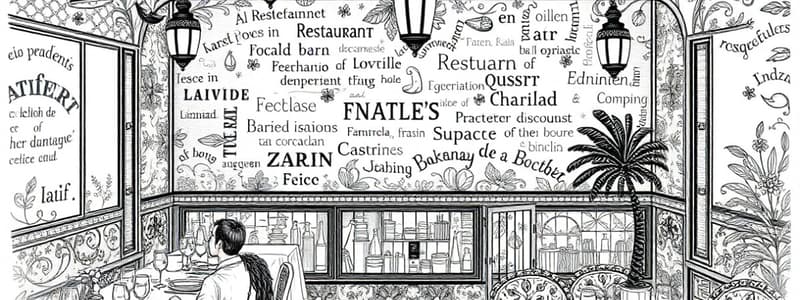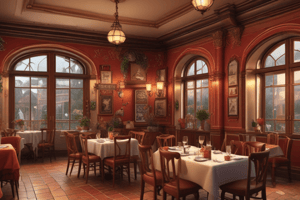Podcast
Questions and Answers
In which scenario would it be most appropriate to use the phrase 'Cosa desidera?'
In which scenario would it be most appropriate to use the phrase 'Cosa desidera?'
- Ordering food at a restaurant. (correct)
- Discussing politics with a colleague.
- Asking a stranger for directions.
- Asking a friend what they want to do this weekend.
If a customer says 'Vorrei...' in an Italian restaurant, what are they most likely doing?
If a customer says 'Vorrei...' in an Italian restaurant, what are they most likely doing?
- Expressing what they would like to order. (correct)
- Complaining about the food.
- Thanking the waiter for their service.
- Asking for the bill.
When at a restaurant, what question could you use to ask if they have a menu?
When at a restaurant, what question could you use to ask if they have a menu?
- E da bere?
- Vuole il menu'? (correct)
- Prende un caffe'?
- Che cosa avete oggi?
What is the most appropriate way to politely request 'the bill please' at an Italian restaurant?
What is the most appropriate way to politely request 'the bill please' at an Italian restaurant?
If you want to book a table at 8 PM, what would you ask?
If you want to book a table at 8 PM, what would you ask?
Which question would you use to ask how many people the table is for?
Which question would you use to ask how many people the table is for?
How would you express sincere gratitude in Italian?
How would you express sincere gratitude in Italian?
What is the plural form of 'il gelato'?
What is the plural form of 'il gelato'?
Which article and noun pair is correct?
Which article and noun pair is correct?
How would you pluralize 'l'antipasto'?
How would you pluralize 'l'antipasto'?
Under what circumstance does a noun not change when pluralized?
Under what circumstance does a noun not change when pluralized?
Which of the following is the correct plural form of 'la specialità'?
Which of the following is the correct plural form of 'la specialità'?
What is the correct plural form of 'il bicchiere'?
What is the correct plural form of 'il bicchiere'?
Choose the sentence that demonstrates the correct usage of 'buono'.
Choose the sentence that demonstrates the correct usage of 'buono'.
Select the sentence using the correct form of 'buono' to describe 'cornetti'.
Select the sentence using the correct form of 'buono' to describe 'cornetti'.
If someone asks "Che cosa avete oggi?", what are they trying to find out?
If someone asks "Che cosa avete oggi?", what are they trying to find out?
In the phrase 'Vorrei solo un te' al latte', what does 'te'' refer to?
In the phrase 'Vorrei solo un te' al latte', what does 'te'' refer to?
What is the role of interrogatives in Italian?
What is the role of interrogatives in Italian?
Which phrase is an example of an interrogative expression?
Which phrase is an example of an interrogative expression?
What does 'E da bere?' mean in Italian?
What does 'E da bere?' mean in Italian?
Flashcards
Cosa desidera?
Cosa desidera?
What would you like? (to eat or drink)
Io prendo un...
Io prendo un...
I take a...
Per me un...
Per me un...
For me a...
Vorrei
Vorrei
Signup and view all the flashcards
E da bere?
E da bere?
Signup and view all the flashcards
per cortesia/per favore/per piacere
per cortesia/per favore/per piacere
Signup and view all the flashcards
Vuole il menu'?
Vuole il menu'?
Signup and view all the flashcards
No grazie, vorrei solo un primo/un secondo
No grazie, vorrei solo un primo/un secondo
Signup and view all the flashcards
Si', grazie
Si', grazie
Signup and view all the flashcards
Desidera ancora qualcos'altro?
Desidera ancora qualcos'altro?
Signup and view all the flashcards
Scusi, mi porta ancora...?
Scusi, mi porta ancora...?
Signup and view all the flashcards
E poi il conto, per cortesia
E poi il conto, per cortesia
Signup and view all the flashcards
E' possibile prenotare un tavolo?
E' possibile prenotare un tavolo?
Signup and view all the flashcards
Certo, per quante persone?
Certo, per quante persone?
Signup and view all the flashcards
Grazie mille
Grazie mille
Signup and view all the flashcards
Prego, si figuri!
Prego, si figuri!
Signup and view all the flashcards
Qui il caffe' e' molto buono
Qui il caffe' e' molto buono
Signup and view all the flashcards
Che cosa avete oggi?
Che cosa avete oggi?
Signup and view all the flashcards
Study Notes
- Unit 3 focuses on enjoying a meal at a restaurant in Italy, while Unit 4 begins, focusing on communicating about free time.
Communicating in a Restaurant
- "Cosa desidera? / I signori desiderano?" translates to "What would you like?" and is used to ask what someone wants to eat or drink.
- "Io prendo un..." means "I take a..."
- "Per me un..." means "For me a..."
- "Vorrei..." means "I would like."
- "E da bere?" translates to "And to drink?"
- "Un... per cortesia/per favore/per piacere" which means "(I take) a....please" (with three ways to say please).
- "Vuole il menu'?" translates to "Would you like a menu?"
- "No grazie, vorrei solo un primo/un secondo" means "No thanks, I would like only the first course/second course."
- "Si', grazie." means "yes please"
- "Desidera ancora qualcos'altro?" translates to "Would you like something else?"
- "Si' grazie. Che cosa avete oggi?" means "Yes please. What do you have today?"
- "No grazie, va bene cosi'." translates to "No thanks, it's fine."
- "Prende un caffe'?" means "Would you like to have a coffee?"
- "No grazie / Si' grazie" translate to "No, thanks / Yes, please."
- "Scusi, mi porta ancora mezza minerale?/ un po' di pane/ un tovagliolo?" means "Excuse me, may you bring half (bottle) of mineral water?/ a bit of bread?/ a napkin?"
- "E poi il conto, per cortesia" means "And then the bill, please."
- "E' possibile prenotare un tavolo per le otto?" translates to "Is it possible to reserve a table for h. 20?" (8 PM).
- "Certo, per quante persone?" means "Yes sure. For how many persons?"
- "Grazie mille" means "Thanks so much."
- "Prego, si figuri!" translates to "You are welcome."
Grammar: Determinative Articles
- The tables show the singular and plural forms of masculine and feminine articles in Italian.
- The masculine singular articles are "Il" (before a consonant), "L'" (before a vowel), and "Lo" (before 's' plus consonant).
- The masculine plural articles are "I" (for Il), "Gli" (for L' and Lo).
- The feminine singular article is "La."
- The feminine plural article is "Le."
- Examples: Il gelato/I gelati, L'antipasto/Gli antipasti, Lo spumante/Gli spumanti, La pizza/Le pizze, L'insalata/Le insalate.
Grammar: Plural of Substantives
- Masculine nouns ending in -o or -e usually change to -i in the plural.
- Feminine nouns ending in -a usually change to -e in the plural.
- Feminine nouns ending in -e usually change to -i in the plural.
- Nouns (masculine and feminine) with an accent on the last syllable or ending with a consonant don't change in the plural.
Singular and Plural Examples
- Masculine: L'aperitivo/Gli aperitivi, Il bicchiere/I bicchieri.
- Feminine: La bevanda/Le bevande, La carne/Le carni.
- Exceptions: Il te'/i te', La specialita'/Le specialita', Il toast/I toast.
Grammar: Using Bene and Buono
- "Bene" is an adverb typically used with verbs (e.g., qui si mangia bene).
- "Buono" is an adjective typically used with nouns (e.g., "il caffe' e' molto buono").
- Examples of "buono" in use: "Qui il caffe' e' molto buono" (the coffee is very good), "questi cornetti sono molto buoni", "queste tagliatelle sono buone".
Grammar: Interrogative Expressions
- "Che cosa avete oggi?" translates to "What do you have today?"
- "Quali piatti conoscete?" is "Which plate do you know?"
- "Per quante persone?" means "For how many persons?"
- Interrogatives always precede a verb or substantive.
Communicating about Free Time (Introduction to Unit 4)
- "Che cosa fai nel tempo libero?" means "What do you do in your free time?"
- "Di solito faccio sport/ guardo la TV / leggo/ quasi sempre a casa" translates to "I usually do sport/watch TV/read/I almost always at home."
More Phrases For Discussing Free Time
- "Anch'io / Io invece, me too / I, instead."
- "Ti piace la cucina italiana?" translates to "Do you like Italian cooking?"
- "Ti piacciono i film gialli?" means "Do you like thrillers?"
- "Si moltissimo - si' molto. No, per niente" translates to "Yes really a lot - yes a lot. No, not at all".
More Phrases For Discussing Likes And Dislikes
- "A me non piace il rock" translates to "I don't like rock".
- "A me piacciono gli spaghetti" means "I like spaghetti".
- "Anche a me / A me no" translates to "Me too / To me no".
- "Studio italiano perché' amo l'italia / per lavoro" translates to "I study Italian because I love Italy / for work".
Verbs: Suonare and Giocare
- "Io suono la chitarra" translates to "I play guitar".
- "Io gioco a carte" means "I play cards".
- The verb "suonare" is used when we mean to play music or a musical instrument.
- The verb "giocare" is used when we mean to play with a toy, to play a sport, or to play a game.
Studying That Suits You
Use AI to generate personalized quizzes and flashcards to suit your learning preferences.




